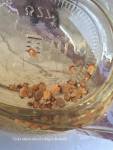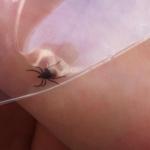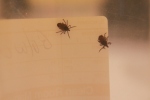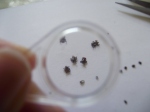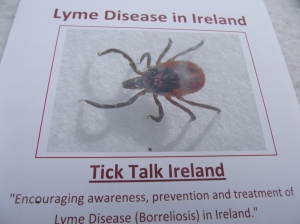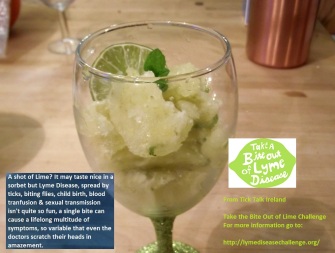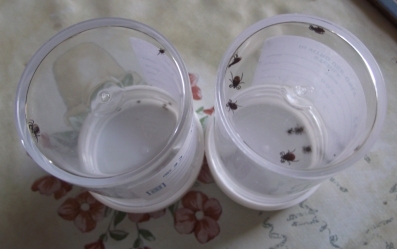
Lyme Disease is such a peculiar affair. In a recent radio chat pitching doctors did agree on one thing, acute (early) lyme & chronic lyme are two completely different entities. Ask a patient who just had a rash & was treated early & they’d say ah it was nothing, few weeks antibiotics & I was good to go. Those who skipped stage one or didn’t get a rash, or didn’t get an astute doctor making a quick diagnosis or didn’t the right kind of results on blood tests (even when it’s known that blood tests can give incorrect results) are the ones sadly being left behind. And it’s these folks who develop chronic symptoms. Chronic or late stage symptoms look NOTHING like early Lyme. A doctor will tell you it can’t be Lyme you have a negative result, or it can’t be Lyme you didn’t have a rash, it can’t be Lyme you have far too many symptoms (therefore you must be sick in the head right?) or it can’t be Lyme as it doesn’t exist here in Ireland (yes that’s still happening despite all our hard work)
So let’s look at some of the problems….
There’s no such thing as seronegative lyme
– (actually there’s no such thing as a 100% accurate test but that fact seems to be ignored)
First let’s take a look at the testing. Back in the 90’s a vaccine was being developed to prevent lyme disease. This was a great leap forward especially as lyme was outstripping cases of AIDS & is the fastest growing vector-borne disease in the Western Hemisphere. Also it can be a debilitating & longterm illness which puts a strain on the patient, the family & the welfare system. BUT there was a problem. Firstly they realised that anyone being tested for Lyme would automatically react to certain bands on the testing. Borrelia can produce outer surface proteins but so can the Lyme vaccine. So to prevent anyone being tested falsely positive for Lyme in the future they decided to restrict the banding & bands 31 & 34 were taken out. Then along came the vaccine. Conflicting reports ensued, the manufacturers of the vaccine said that Lymerix was withdrawn from market due to poor sales, other reports say that patients were finding themselves succumbing to the disease AFTER being vaccinated. Was this being caused by the vaccine itself? Some unfortunate folks with a certain gene type HLA-DR4 (see PDF) could also succumb to antibiotic refractory arthritis – FOR LIFE. Not good from a vaccine. Others with a latent infection could then have an acute infection triggered by the vaccine itself. So in any case the vaccine was withdrawn BUT the bands remained restricted.
Along came even more confusion, the CDC stated that for SURVEILLANCE CRITERIA only that for testing purposes the following 2 tier testing system should apply: (2 tier testing requires a positive or borderline ELISA followed by a positive WB using the newly restricted criteria).
For the purposes of surveillance, the definition of a qualified laboratory assay is
1. Positive Culture for B. burgdorferi, or
2. Two-tier testing interpreted using established criteria [1], where:
a. Positive IgM is sufficient only when ≤30 days from symptom onset*
b. Positive IgG is sufficient at any point during illness**
3. Single-tier IgG immunoblot seropositivity using established criteria [1-4].
4. CSF antibody positive for B. burgdorferi by Enzyme Immunoassay (EIA) or Immunofluorescence Assay (IFA), when the titer is higher than it was in serum
*Postive IgM = 2 of the following 3 bands present: 24 kDa (OspC), 39 kDa (BmpA), and 41 kDa (Fla)
**Positive IgG = 5 of the following 10 bands are present: 18 kDa, 21 kDa (OspC), 28 kDa, 30 kDa, 39 kDa (BmpA), 41 kDa (Fla), 45 kDa, 58 kDa (not GroEL), 66 kDa, and 93 kDa
They also state that this surveillance case definition was developed for national reporting of Lyme disease; it is not intended to be used in clinical diagnosis, however despite the shortfalls in testing using this 2 tier method many doctors simply WILL NOT diagnose Lyme without a positive result. So what are the shortfalls in testing?
One is that both tests are reliant on the production of antibodies to specific strains. A person can have a different strain to that being tested (despite reports saying that other strains may be non pathogenic a few reports counter that some of the less commonly tested strains can in fact cause symptoms so we need to keep an open mind).
In fact in Ireland we have very high levels of strain VS116 – B. valaisiana (shown in 50% of infected ticks in one study). The studies below shows possible pathogenic* problems regarding this strain so we maybe missing many patients by not testing for it..
*Group VS116 was detected in two EM patients, and therefore this group has pathogenic potential. Mixed infections of B. afzelii and B. garinii, group VS116 or B. burgdorferi sensu stricto were found in three EM and three ACA patients.
*Indirect evidence suggests that B. valaisiana is involved in some chronic clinical manifestations. We report the genetic detection of B. valaisianain the CSF of a 61-year- old man with a history of spastic paraparesis, which is strong clinical evidence of advanced neuroborreliosis.
Antibiotics may abrogate immune response. In fact some say that patients may never seroconvert after antibiotics but still have an infection* and antibody response may vary per person aswell as during the course of the illness**
*Immunoblot seroconversion can only be documented in a follow-up sample, and, sometimes, even this option is blocked because antibiotic treatment may interfere with the development of the anti- Borrelia antibody response.
**With respect to the course of IR [immune response] after therapy, 21 of 61 (34%) patients did not show IgM seroconversion (constantly negative), whereas 12 (20%) were constantly positive. In the remaining 28 patients, different kinds of IgM seroconversion occurred. Nine patients (15%) seroconverted from positive to negative and 6 (11%) from negative to positive during the observation period. Seven seronegative patients (11%) seroconverted to positive and than back to seronegative during the 12 months. Six patients (10%) showed repeated seroconversions of IgM antibodies that presented as a switch of anti-23kD to anti-39 kD antibodies and vice versa or the dis-or reappearance of either anti-23 kD or anti-39kD antibodies.
Some say steroids can inhibit immune response – could this also affect testing?
Some co-infections carried by ticks can cause immune suppression possibly affecting test results.
The test kit states “The diagnosis of Lyme disease must be made based on history, signs (such as erythema migrans), symptoms, and other laboratory data, in addition to the presence of antibodies to B. burgdorferi.
*Negative results (either first- or second step) should not be used to exclude Lyme disease.*
Thus, (in their own words) “serological tests for antibodies to B. burgdorferi are known to have low sensitivity and specificity, and because of such inaccuracy, these test cannot be relied upon for establishing a diagnosis of Lyme disease”.
The other downfall with 2 tier testing is that the 2nd tier tends only to be offered after a positive first tier. If the 1st tier missed a patient due to problems listed above they will never be offered the 2nd test. What’s worse, if they do get a positive & do not produce enough BANDS in the 2nd test they still won’t get a positive (remember the restrictive bands mentioned in the first part? Well less bands available for testing = less bands available for reacting & so more false negatives will result.) For IgG testing for instance a person needs to obtain 5 out of 10 bands to be positive. So if lyme specific bands were taken out you can see why this makes no sense at all. An astute lyme doctor would request an Igenex WB for example & pick out the bands the patient reacted to & identify which are lyme specific. You have some lyme specific bands? Well then you most probably have lyme disease, it’s that simple. But the method currently used is you have less than 5 out of 10 bands, then you don’t have lyme disease. Where’s the logic in that? As Tom Grier mentioned in his article, children tested AFTER the testing band criteria were restricted are now more likely to be a negative. He states “under the old criteria, all of 66 pediatric patients with a history of a tick bite and Bull’s Eye rash who were symptomatic were accepted as positive under the old Western Blot interpretation. Under the newly proposed criteria, only 20 were now considered positive”. Would you want your child undiagnosed with an illness that can seriously affect the brain due to such hit & miss methodology?
Some studies showing problems with 2 tier testing in Europe:
Large differences between test strategies for the detection of anti-Borrelia antibodies are revealed by comparing eight ELISAs and five immunoblots.
http://www.ncbi.nlm.nih.gov/pubmed/21271270
Ang CW, Notermans DW, Hommes M, Simoons-Smit AM, Herremans T.
Eur J Clin Microbiol Infect Dis. 2011 Jan 27. [Epub ahead of print]
VUMC, Amsterdam, The Netherlands, w.ang@vumc.nl.
Comparison of immunoblots yielded large differences in inter-test agreement and showed, at best, a moderate agreement between tests. Remarkably, some immunoblots gave positive results in samples that had been tested negative by all eight ELISAs. The percentage of positive blots following a positive ELISA result depended heavily on the choice of ELISA-immunoblot combination. We conclude that the assays used to detect anti-Borrelia antibodies have widely divergent sensitivity and specificity. The choice of ELISA-immunoblot combination severely influences the number of positive results, making the exchange of test results between laboratories with different methodologies hazardous.
Serodiagnosis of Borreliosis: Indirect Immunofluorescence Assay, Enzyme-Linked Immunosorbent Assay and Immunoblotting.
http://www.ncbi.nlm.nih.gov/pubmed/21258869
Arch Immunol Ther Exp (Warsz). 2011 Jan 22. [Epub ahead of print]
Wojciechowska-Koszko I, Mączyńska I, Szych Z, Giedrys-Kalemba S.
Department of Microbiology and Immunology, Pomeranian Medical University, Powstańców Wielkopolskich 72, 70-111, Szczecin, Poland, IwonaKoszko@interia.pl.
In order to detect the antibodies against Borrelia sensu lato three kinds of serological tests were used: indirect immunofluorescence assay (IIFA), enzyme-linked immunosorbent assay (ELISA), and immunoblot. The IIFA and immunoblot tests conducted on 45 patients (100%) produced positive results for both the IgM and IgG antibody types. In the case of ELISA, positive or borderline results were observed in only 24 patients (53.3%)..The IIFA screening test used for diagnosing Lyme borreliosis produced the highest percentage of positive results, which were then confirmed by immunoblot, but not by ELISA. Therefore using only ELISA as a screening test or for diagnosing Lyme borreliosis seems debatable.
Another reason for seronegativity can be down to antibodies sequestered in immune complexes. As evidenced by these studies…
Diagnosis of Lyme Borreliosis
Aguero-rosenfeld, Maria E Wang, Guiqing Schwartz, Ira Wormser, Gary P, Clin Microbiol Rev. 2005 July; 18(3): 484–509.
http://www.ncbi.nlm.nih.gov/pmc/articles/PMC1195970/
The enzyme-linked IgM capture IC [immune complex] biotinylated antigen assay was found to be more sensitive and specific than the aforementioned tests and furthermore detected antibodies more consistently in those patients with clinical evidence of active disease. Potential utilities of this type of assay include detection of antibodies in seronegative patients during early disease and ascertainment of whether persistent seropositivity is due to ongoing infection, since IC are speculated to be present only in active infection.
Immune complexes from serum of patients with Lyme disease contain Borrelia burgdorferi antigen and antigen-specific antibodies: potential use for improved testing.
Brunner, M Sigal, L H, J Infect Dis. (2000) 182 (2): 534-539.
http://jid.oxfordjournals.org/content/182/2/534.full
Serum from a patient with Bannwarth syndrome (lymphocytic meningitis, cranial neuropathy, and radiculoneuritis) was seronegative by standard isotype-specific IgG ELISA and immunoblot and was positive by IgM ELISA. When the ICs [immune complexes]-and FAs [free antibodies] were used at equal concentrations of IgM, more Bb antigens were bound by IC derived IgM than by FA IgM, including the 23-, 30/31-, and 66-kDa bands of the Centers for Disease Control and Prevention interpretation criteria. Thus, specific IgM was sequestered within ICs.
Binding to the 23-kDa protein was more intense in ICs than in the FA fraction;** FA immunoblot reactivity would have been classified as negative, according to the manufacturer’s instructions. **
We found OspA within ICs of some patients with later features of LD, which is analogous with the persisting infection in the mouse. These findings suggest that OspA may be expressed in long-term infection; the appearance of anti-OspA antibodies in later disease suggests that this antigen is present to elicit that humoral response
One potential explanation for the absence of serological reactivity with OspA in standard serological assays in many patients with later manifestations of LD may be that anti-OspA antibodies are sequestered within ICs.
Benjamin J. Luft, M.D. Professor, Chair (acting) Department of Medicine, State University of New York at Stony Brook says it all:
“Since Lyme disease is a clinical diagnosis, research must continue to improve diagnostic assays using recombinant proteins which are more sensitive and specific than the whole organism sonicate used for both ELISA and Western blots. Possible biological markers of chronic Lyme disease, such as positive Borrelial antigen, Borrelial DNA and pleocytosisin the CSF or synovial fluid, need to be assessed and validated. Elimination of biological markers in combination with sensitive indices of neuropsychological symptoms will be useful for the evaluation of treatment modalities.”
Those ‘other’ tests used abroad are not accredited
– (well depends on your definition of accredited!)
Of course what they mean is that they are not accredited for use in the 2 tier system & the 2 tier system is considered the ‘gold standard’ despite its set backs. Any others tests used are treated with suspicion, however saying they’re not accredited maybe pushing it slightly. For instance the test kit used for Elispot techniques is CE approved (a quality mark for use throughout Europe). Igenex testing in the States is heavily quality controlled & surpasses expectations. Remember there’s no test that’s a 100% BUT ignoring other tests just because it’s not in line with the 2 tier testing that A. follows RESTRICTED criteria (due to the vaccine issues mentioned above) & B. was only meant for SURVEILLANCE not diagnostic criteria, just makes no sense.
Elispot or LTT testing looks at immune responses in a different way, for instance looking at T cell activity against the lyme bacteria. According to this study it is entirely possible for patients to exhibit T-cell activity without showing positive antibodies: “We studied 17 patients who had presented with acute Lyme disease and received prompt treatment with oral antibiotics, but in whom chronic Lyme disease subsequently developed. Although these patients had clinically active disease, none had diagnostic levels of antibodies to B. burgdorferi on either a standard enzyme-linked immunosorbent assay or immunofluorescence assay.
We conclude that the presence of chronic Lyme disease cannot be excluded by the absence of antibodies against B. burgdorferi and that a specific T-cell blastogenic response to B. burgdorferi is evidence of infection in seronegative patients with clinical indications of chronic Lyme disease.
Igenex meanwhile do the 2nd tier test (Western Blot) but DO NOT use restrictive criteria. In other words they put back in bands 31 & 34 that were restricted during the Dearborn Convention. If you were testing your own children or family member wouldn’t you want the best? So why aren’t patients allowed the best too?
As Lyme disease has the potential to spread throughout the body (it doesn’t care whether it’s in tissue,the blood, organs, behind the eyes, in the heart, in joints or even in the brain) it can be a serious infection that’s difficult to treat. Why should patients go untreated just because someone somewhere says that overseas testing should be discredited even though they have the potential to pick up more cases?

If you had lyme you’d see a rash
– (or maybe not)
There is a familiar pattern going around the world. Patients, doctors & the public are repeatedly told that lyme will nearly always emit a bulls-eye shaped lesion days to weeks after a bite. Some studies I’ve seen suggest up to 90% of patients others as low as 50%. Another actually suggested as low as 9%* are typical bulls-eye (EM) lesions the rest are multiple EM rashes, uniform EM rashes in fact a whole manner of forms**. Rashes can appear by the bite, away from it, can repeatedly occur throughout the illness. According to a study at the Univ College Hospital they found “While twenty-two patients (71%) had a rash at presentation, only 43% of patients presented with EM rash“.
Results of our own surveys (word doc) found that the erythema migrans (EM) rash was only present in 44% of the patients at the start of the illness and 19% have multiple EM’s during the course of the illness. This shows that a rash is not always present or noticed during Stage One of the illness… Also differing strains can cause differing skin reactions so really it is hard to pin down an exact percentage. Just be known that a bulls-eye rash does not appear in everyone & those who do get a rash it may not be conforming to the normal picture portrayed. Some pics of differing rashes can be seen at: http://www.ticktalkireland.org/diagnosis.html
*[PDF]The EM lesion has been classically described as erythematous with central clearing, the so-named “bull’s eye” appearance (Figure 3) (4). However, in a study of 118 cases of EM, in which Borrelia burgdorferi infection was confirmed by culture or polymerase chain reaction, the lesion was homogeneous in 59%, had central erythema in 32% (Figure 4), and was a “bull’s eye” with central clearing in only 9%.
**In another study that contains pics of various rashes” While 80% of EM in the United States are uniformly red, only 19% have the stereotypical bull’s eye appearance [5].
While typically circular or oval, it can also be triangular, rectangular or distorted in other ways when occurring in areas such as the neck [6]. Atypical features may include erythema with central induration, urticarial like lesions, confluent red-blue lesions mimicking ecchymosis, vesicles mimicking shingles, and central necrosis mimicking spider bites”
Lyme does not exist here in Ireland
– (yes this is still being said despite the reverse being true & has been untrue for many years)
This comment riles me. The internet is so full of information that there is no excuse NOT to realise that Lyme exists in Ireland. Prof Gray from the 90’s had tons of papers identifying high risk areas & the disease that ticks may carry. If a doctor mentions this to you then they haven’t spent the time learning. You can’t treat a patient for something you don’t think exist. Learning is key for all of us – ignorance is not. For some of the Irish related studies go to https://ticktalkireland.wordpress.com/lyme-links/irish-related-articles/
Lyme does not become chronic, in fact a few weeks antibiotics should see you right
– (not so according to many studies even by IDSA guideline authors themselves..)
Well anyone in the Lyme world, doctor or patient knows how frustrating this topic can be. First as a patient you have to jump through the hoop of diagnosis (did anyone recognise the symptoms?) then the testing (did you manage to get a positive or did you manage to get overseas test taken seriously?) If you’re eventually offered treatment after being years without a diagnosis you may find that nothing happens! Why? Because you may have been treated too little too late. Don’t get me wrong, I don’t advocate endless years of treatment to the point where the patient becomes so toxic they can’t function at all BUT I think lack of treatment or too little treatment after years of waiting for a diagnosis is an insult. Anyone who has lived a day in the life of a chronically ill Lyme patient knows how awful it is. Remember how crap you feel during a bout of flu? Well a lyme patient suffers from that sometimes on a weekly basis, the chills, weakness, muscles ache, joint pains, severe headaches, pains behind the eyes, sore throats, swollen glands – it ain’t pretty. Throw in a few heart palpitations or a racing heart, some numbness & tingling, swellings in unusual places, chronic bladder pain, back troubles, stiff neck & knees & you’d be welcoming treatment with open arms wouldn’t you? But what happens when they refuse to treat you. Hold on, there’s no lyme in ireland, you didn’t have a rash, your tests were negative (any positive ones from overseas? Let’s ignore those) & the 3 weeks antibiotics I gave you would have killed it anyway so proof you didn’t have Lyme in the first place. Heard all these before?
But can lyme really persist? These folks seem to think so:
Survival of Borrelia burgdorferi in antibiotically treated patients with
Lyme borreliosis.
http://www.ncbi.nlm.nih.gov/pubmed/2613324
Preac‐Mursic V, Weber K, Pfister HW, Wilske B, Gross B, Baumann A, Prokop J.
Neurologische Klinik Grosshadern, München, FR Germany.
Abstract
Antibiotic therapy may abrogate the antibody response to the infection as shown in our patients. B. burgdorferi may persist as shown by positive culture in MKP-medium; patients may have subclinical or clinical disease without diagnostic antibody titers to B. burgdorferi. We conclude that early stage of the disease as well as chronic Lyme disease with persistence of B. burgdorferi after antibiotic therapy cannot be excluded when the serum is negative for antibodies against B. burgdorferi.
Spirochetes in the spleen of a patient with chronic Lyme disease.
http://www.ncbi.nlm.nih.gov/pubmed/2910019
Cimmino MA, Azzolini A, Tobia F, Pesce CM.
Istituto Scientifico di Medicina Interna, Università di Genova, Italy.
Abstract
A 54-year-old man had intermittent evening fever, arthralgia, transient erythematous macular eruption on the skin, and splenomegaly of two year’s duration. Immunofluorescence tests for Borrelia burgdorferi serum antibodies had positive results, but G-penicillin treatment was ineffective. Splenectomy with lymph node biopsy was performed to rule out lymphoproliferative disorders. Borrelia-like spirochetes were identified histologically in the spleen; this finding was consistent with persistence of B. burgdorferi organisms in inner organs in chronic Lyme disease.
Chronic neurologic manifestations of Lyme disease.
http://www.ncbi.nlm.nih.gov/pubmed/2172819
Logigian EL, Kaplan RF, Steere AC.
Department of Neurology, Tufts University School of Medicine, Boston, MA 02111.
Abstract
BACKGROUND AND METHODS: To define further the chronic neurologic abnormalities of Lyme disease, we studied 27 patients (age range, 25 to 72 years) with previous signs of Lyme disease, current evidence of immunity to B. burgdorferi, and chronic neurologic symptoms with no other identifiable cause. Eight of the patients had been followed prospectively for 8 to 12 years after the onset of infection.
Clinical implications of delayed growth of the Lyme borreliosis spirochete,
Borrelia burgdorferi.
http://www.ncbi.nlm.nih.gov/pubmed/1980573
MacDonald AB, Berger BW, Schwan TG.
Department of Pathology, Southampton Hospital, New York 11968.
Abstract
The latency and relapse phenomena suggest that the Lyme disease spirochete is capable of survival in the host for prolonged periods of time. We studied 63 patients with erythema migrans, the pathognomonic cutaneous lesion of Lyme borreliosis, and examined in vitro cultures of biopsies from the active edge of the erythematous patch. Sixteen biopsies yielded spirochetes after prolonged incubations of up to 10.5 months, suggesting that Borrelia burgdorferi may be very slow to divide in certain situations. Some patients with Lyme borreliosis may require more than the currently recommended two to three week course of antibiotic therapy to eradicate strains of the spirochete which grow slowly.
Electron microscopy and the polymerase chain reaction of spirochetes from
the blood of patients with Lyme disease.
http://www.ncbi.nlm.nih.gov/pubmed/8004045
Hulínská D, Krausová M, Janovská D, Rohácová H, Hancil J, Mailer H.
Department of Electron Microscopy, National Institute of Public Health, Prague, Czech Republic.
Abstract
Results of studies using direct antigen detection suggest that seronegative Lyme borreliosis is not rare and support the hypothesis that Borrelia antigens can persist in humans.
Lyme borreliosis‐‐a review of the late stages and treatment of four cases.
http://www.ncbi.nlm.nih.gov/pubmed/9701852
Petrovic M, Vogelaers D, Van Renterghem L, Carton D, De Reuck J, Afschrift M.
Department of Internal Medicine, University Hospital Ghent, Belgium.
Abstract
Difficulties in diagnosis of late stages of Lyme disease include low sensitivity of serological testing and late inclusion of Lyme disease in the differential diagnosis. Longer treatment modalities may have to be considered in order to improve clinical outcome of late disease stages. The different clinical cases illustrate several aspects of late borreliosis: false negative serology due to narrow antigen composition of the used ELISA format, the need for prolonged antibiotic treatment in chronic or recurrent forms and typical presentations of late Lyme disease, such as lymphocytic meningo-encephalitis and polyradiculoneuritis.
Treatment of late Lyme borreliosis.
http://www.ncbi.nlm.nih.gov/pubmed/7884218
Wahlberg P, Granlund H, Nyman D, Panelius J, Seppälä I.
Department of Medicine, Aland Central Hospital, Mariehamn, Finland.
[From the abstract:] “Short periods of treatment were not generally effective.”
[From the article:] “Symptoms and signs often improve temporarily shortly after treatment but reappear within weeks or months. …To conclude, we have shown that long-term treatments beginning with intraveous ceftriaxone and continuing with amoxycillin plus probenecid or with cephadroxil were useful in the treatment of late Lyme borreliosis.” (pp. 260-1)
First isolation of Borrelia burgdorferi from an iris biopsy.
http://www.ncbi.nlm.nih.gov/pubmed/8106639
Preac‐Mursic V, Pfister HW, Spiegel H, Burk R, Wilske B, Reinhardt S, Böhmer R.
Max v. Pettenkofer Institut für Hygiene u. Medizinische Mikrobiologie, LM‐Universität München,
Germany.
Abstract
The persistence of Borrelia burgdorferi in six patients is described. Borrelia burgdorferi has been cultivated from iris biopsy, skin biopsy, and cerebrospinal fluid also after antibiotic therapy for Lyme borreliosis. Lyme Serology: IgG antibodies to B. burgdorferi were positive, IgM negative in four patients; in two patients both IgM and IgG were negative. Antibiotic therapy may abrogate the antibody response to the infection as shown by our results. Patients may have subclinical or clinical disease without diagnostic antibody titers. Persistence of B. burgdorferi cannot be excluded when the serum is negative for antibodies against it.
So where to go from here.
Let’s stop restrictive practises, restrictive banding on testing, restrictive guidelines (thou’ must not treat long term) & restrictive attitudes. Only then can we move on. As Stella Huyshe-Shires eloquently put it in a recent hearing ‘To us in the UK there seem to be two principal aspects to the Lyme disease problem: politics and the uncertainties of the science. The first is preventing recognition of the second. Politics, prestige and defence of positions should not obstruct patient care and should not hamper the search for understanding’. Stella Huyshe-Shires: Chairman, Lyme Disease Action, UK.
And all these lyme patients are feeling neglected. We won’t go away, not because we don’t want to, it’s because we can’t.
“The controversy in Lyme disease research is a shameful affair” says Willy Burgdorfer
I’d like to finish off with this quote from an interview with Willy Burdgorfer himself (the scientists who identified the bacteria causing lyme disease)
Dr. Burgdorfer: “The controversy in Lyme disease research is a shameful affair. And I say that because the whole thing is politically tainted. Money goes to people who have, for the past 30 years, produced the same thing—nothing. Serology has to be started from scratch with people who don’t know beforehand the results of their research. There are lots of physicians around who wouldn’t touch a Lyme disease patient. They tell the nurse, “You tell the guy to get out of here. I don’t want to see him.” That is shameful. So [this] shame includes physicians who don’t even have the courage to tell a patient, “You have Lyme disease and I don’t know anything about it.”
Some useful posts:
Myths about Lyme Disease
Blood testing
WB comparison (excel)
Persistence & seronegativity (PDF)
A look at patents (word doc)
Video clip from Dr Shor explaining the problems evident in the Lyme world
A doctor’s dilemma by Dr. McNeil
Our useful links page – Lyme & MS, Lyme & ME, rashes, chronic lyme etc.
Read Full Post »
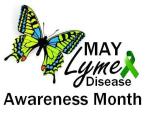

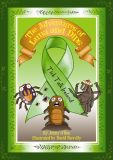



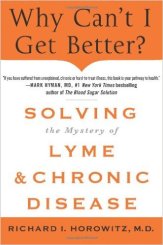 As Dr Horowitz says in his
As Dr Horowitz says in his 


 72 out of our 104 respondents have been ill for more than a year in TOTAL including pre & post treatment which is an alarming 69%. Nearly a QUARTER of these patients have been ill for 10 years or longer. This supports the claim that Lyme MUST be treated quickly to avoid chronic and persistent infection.
72 out of our 104 respondents have been ill for more than a year in TOTAL including pre & post treatment which is an alarming 69%. Nearly a QUARTER of these patients have been ill for 10 years or longer. This supports the claim that Lyme MUST be treated quickly to avoid chronic and persistent infection.
